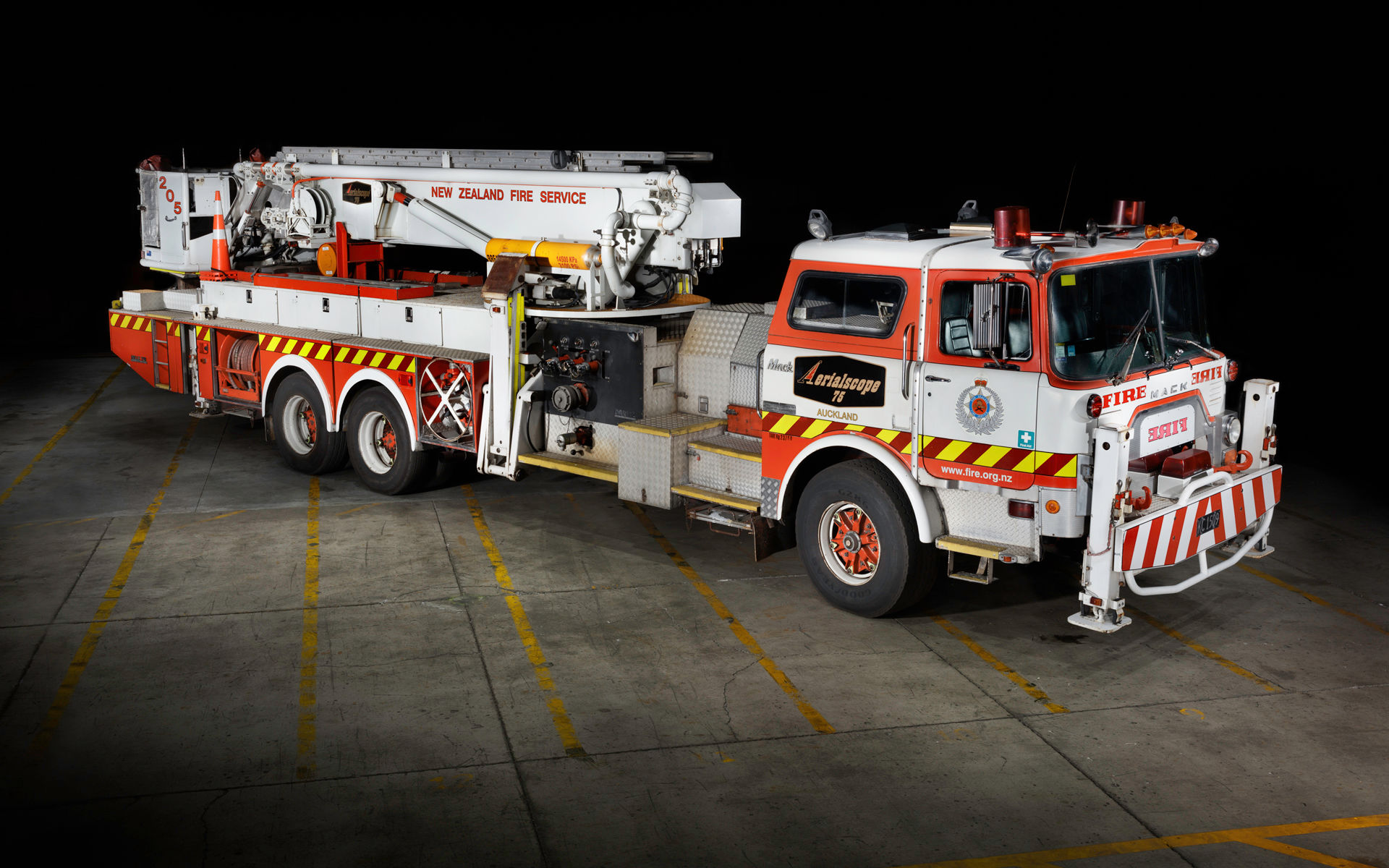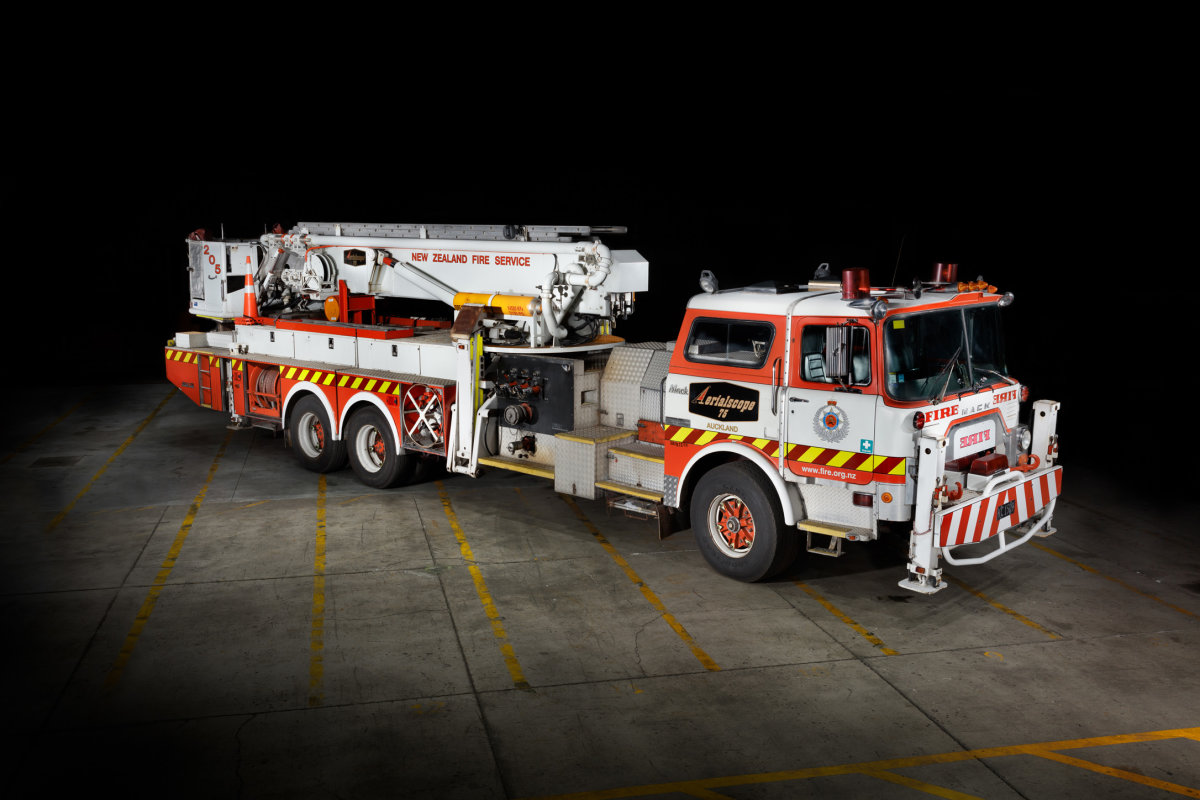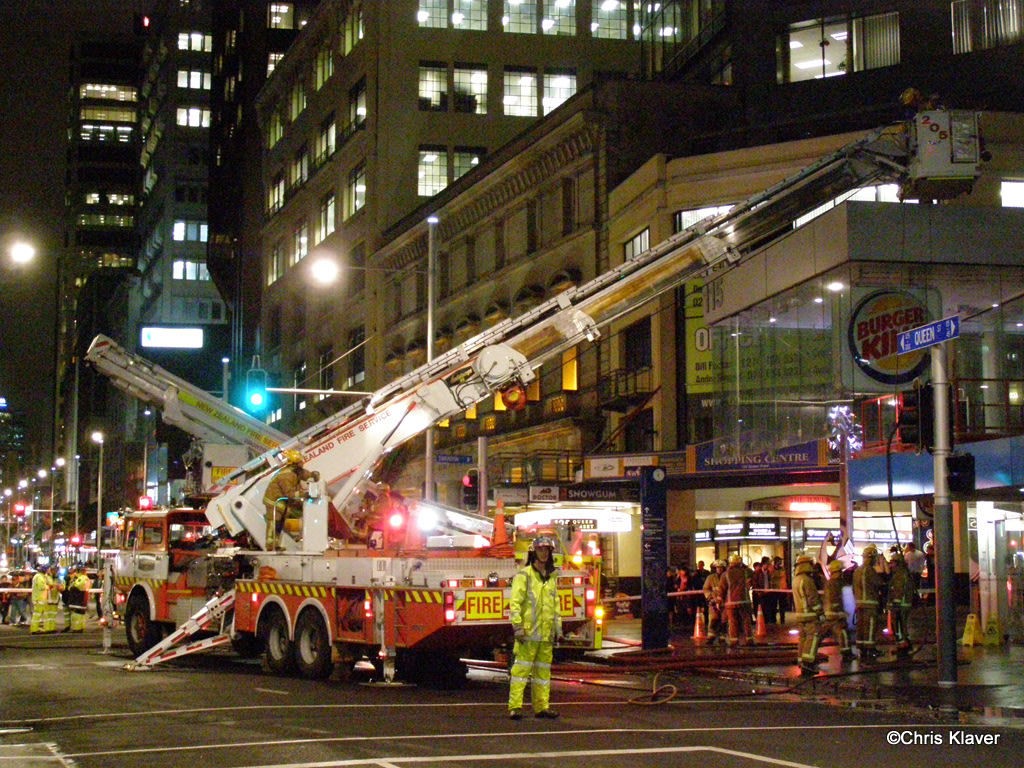One of a Kind: MOTAT’s Mack Aerialscope


One Of a Kind: MOTAT’s Mack Aerialscope
This 1981 Mack 75 Aerialscope was manufactured in Allentown, Pennsylvania (USA) after being commissioned by the New Zealand Fire Service (NZFS) to improve response to major fires. It is a Baker Aerialscope installed on a Mack CF612 truck chassis with components assembled locally by Mills-Tui in Rotorua. It was based at Auckland’s Central Fire Station for its entire 31 years of service and attended major fires across the city, before being donated to MOTAT by NZFS. This type of fire appliance is designed to pump a high volume of water on fires, operating at height to do so.
A rare example
The truck and bus manufacturing company, Mack, began building fire engines almost from their beginnings in 1900, as a small percentage of their production, and earned a reputation for producing high quality appliances. In 1956, the company purchased the CD Beck Company of Sydney, Ohio, which had been making intercity buses and fire engines. This acquisition led to a new line of forward-cab fire engines that became the basis of the Mack model C appliances, superseded by the CF range (Georgano, 1979).
The CF came in 10 different variations, from CF600 through to CF800. MOTAT’s Mack is a CF612 with a Baker Aerialscope installed onto the chassis that could extend 22.86 metres to grapple with fires in taller buildings. Installation onto a chassis was safer as ladders got taller, making operation more stable and helping the appliance arrive faster to emergencies (Lott, 2012).
At least 3849 fire appliances on CF chassis were built between 1967 and 1990 but MOTAT’s is a one-off, being the only right-hand drive Mack Aerialscope assembled in the entire world (Lott, 2012). It is also the only one fitted with a Darley pump and the only Mack Aerialscope to serve its working life outside of continental North America (Lott, 2012, p. 18).
Mack was known as a premium fire appliance brand and was introduced in limited quantities to the New Zealand Fire Service. Other Mack fire appliances commissioned around that period included Wellington’s four Mack CF pumpers, and Auckland’s two CF Thibault telebooms. There was also a MC Snorkel and another Mack MC teleboom/foam tender in Petone, along with a Mack CF Snorkel in Dunedin.
This Aerialscope was ordered to replace the aging 1971 International Snorkel with a Cincinnati cab, an appliance that is also in the MOTAT collection. Acquisition of the Aerialscope followed an investigation into the Fire Services performance at major fires. It was determined the service needed an aerial capability that would reach over a building of two floors and flow large volumes of water. Investigations were carried out overseas and the Aerialscope selected as the most viable option.
When first developed, Aerialscopes quickly became popular with New York firefighters. They suited dense cities with the challenge of tall buildings set back from the road, meaning reach was crucial, along with the ability to navigate narrow streets with parked cars (Lott, 2012). Allen Bruce, a New Zealand firefighter and officer, witnessed them in action in New York and visited the Mack plant while it was building the vehicle that would become the MOTAT example.
Bruce worked on the acquisition for this Mack Aerialscope with the Fire Commissioner, Frank Hardy, who had also travelled to England and the United States to review modern appliances. The Mack was a significant investment for the relatively recently formed New Zealand Fire Service (1975). Fire appliances cost around $120,000 in 1980 and the Mack was thought to be close to ten times that amount (Lott, 2012). Both Hardy and Bruce believed it was what Auckland needed, with its combination of a large pump and aerial capabilities (Lott, 2012.)

Image: Courtesy of Nigel Capon, supplied by Derek Quinn.
The Auckland-bound Mack Aerialscope arrived in 1981 and was assembled by Mack dealers, Motor Truck Distributors, in Palmerston North. The cab and chassis then went to Mills Tui Ltd in Rotorua who fitted the outriggers and jacks along with the turntable and booms. They then fitted the Darley pump, built the body, and painted it before handing it over to NZFS. The vehicle was also fit with oversize “Super Single” tyres to the front to comply with the Ministry of Transport’s axle-loading restrictions before being handed to the New Zealand Fire Service to be put into commission.
Another modification was made for Auckland’s hilly conditions when the long rear overhang of 4.5 metres led to problems and the appliance would bottom out on steep streets – the rear locker space was trimmed on an upward angle from the rear access ladder. Mack trucks of this type also had a large red oscillating "Mars light" mounted in the front and centre of the cab. This single, central front light was eventually removed on Auckland’s example, due to a conducting earth problem (Lott, 2012, p. 21).
In practice, it was not unknown for the “Scope” to be positioned with the basket in the large doorways of a well-involved building and both monitors used, each supplying 2200 litres per minute. To safely supply this volume of water to the appliance pump, a remote hydrant called a “Maverick” was used, which allowed several large-capacity supply lines to be collected at a safe location and water fed to the pump through an extra-large hose line. With all hoses running, the appliance was capable of delivering in excess of a 4.5 tonnes of water per minute with a suitable water supply connected.
Technology at new heights: the telescopic ladder
The most notable feature of the appliance is the Aerialscope telescopic ladder by Baker Equipment Engineering Company (Model 5070-0008). They are termed telescopic ladders because, when retracted, each section slides into another and back out to extend – think along the lines of an umbrella. Baker, an American company based in Richmond, USA, were best-known for these elevating platforms, the Aerialscope. The primary purpose of the 'scope was to serve as an escape from a multi-storied building or for targeted fire extinguishment from heights.

Showing the telescopic ladder extended and pumping water from heights. Image: Courtesy of Nigel Capon, supplied by Derek Quinn.
The concept for an Aerialscope is thought to have originated with Chicago Fire Commissioner Robert Quinn, who noticed cherry-pickers being used to trim trees. He then challenged Pitman Manufacturing of Missouri to build a unit that would work for the fire service, with the first being delivered in 1958. This snorkel-type unit was on a GMC chassis. These types of trucks grew in popularity, and in 1964 the Fire Department of New York contracted Mack trucks to build a version that could reach six stories high. Originally these were built on petrol-driven Mack trucks but were being fitted only to all-diesel chassis. Eventually, Baker Equipment Engineering Company, who had a lot of work on telescopic equipment for Boeing, took on the Aerialscope component for Mack.
The ‘scope on MOTAT’s Mack appliance can extend to 22.86 metres (75 feet) with its basket and has a horizontal reach of 19.5 metres. It can be operated either from the basket, or from the operator’s platform mounted on the vehicle’s deck. The basket can hold an impressive 450kgs in any position, at any angle, even with water flowing. The two monitors in the basket at the end of the boom could pump 38 litres a second each, additional to the pumps mounted on the truck chassis. A small Emergency Power Unit could return the boom and the jacks to transport position in the event of a mechanical failure.

Image: Showing the telescopic ladder extended and pumping water from heights. Image: Courtesy of Chris Klaver, supplied by Derek Quinn.
In Aerialscope operation, the vehicle and crane are totally supported by six built-in jacks that extend to the ground, plus a single pair of outriggers for stability. Aerialscopes from other manufacturers usually had two sets of outriggers – the single pair made the Mack easier to set up in confined areas. Since Mack supplied the truck chassis to order, the Aerialscope bolted directly to the frame without needing any sub-frames or structural boxes. This allowed the Aerialscope to sit lower on the chassis in a sturdier and more reliable setup than some boom-equipped vehicles. The first section of the boom is steel, and the other three aluminium, and the telescoping sections are fully enclosed to prevent freezing and seizing in cold conditions. (Lott, 2012).
Mack and Baker worked together until 1990 when Mack decided to stop producing fire trucks. Baker ended up partnering with other chassis companies to offer their Aerialscopes to emergency services, Simon-Duplex, Spartan and eventually Seagrave.
Auckland legacy
The Mack Aerialscope in the MOTAT Collection saw over 30 years of service for Auckland, pumping large amounts of water onto the many fire incidents it responded to. Its significance as a part of our heritage was described by Josh Thompson: “This is the truck that has protected property and given hope to many of the city’s residents for over 30 years. But ‘Auckland 205’ has been much more than this; it has created stories and built relationships. It’s a truck that features in many memories of the city’s firefighting past.” (Thompson, 2012.)
You will be able to view the Mack Aerialscope at the Cloud on the 17 March at a free public event celebratng 150 years of firefighting in New Zealand. MOTAT has partnered with Auckland Fire Brigade Museum and Historical Society, along with FENZ to supply a range of historical appliances that have played an important role for Auckland’s emergency history.

Image: Courtesy of Chris Klaver, supplied by Derek Quinn.
Specifications:
Engine type (motive) Mack Thermodyne air-to-air intercooled turbo-diesel ETAZB with six cylinders inline.
Size 11.02 litres
Power 238.6kW
Transmission 4-speed Allison HT-740 automatic
Maximum speed 80kph
Crew 4 (capable of seating 5)
Aerial Baker Equipment Engineering Co. Aerialscope 75 / 5070-0008 with a max working height of 22.86 metres and max horizontal reach of 19.5metres
Pump Darley SH1500 3-stage fed by onboard 400-litre tank, or external water sources.
Sources
Adams, R. (2002). Mack Trucks. St Paul: Motorbooks International.
Bruce, A. (2009). Into The Line of Fire. New Plymouth: PublishMe.
Georgano, G. (1979). The Complete Encyclopedia of Commercial Vehicles. Osceola: Motorbooks International/Krause Publications.
Gillon, G. (1985). United To Protect: An Historical Account of the Auckland Fire Brigade 1848-1985. Auckland: Orion Press.
Lott, D. (2012, December). Cover Story Part 1, Mack (Baker) Aerialscope. Deals on Wheels: Trucks. Auckland, New Zealand: ACP Magazines.
Mills-Tui. (2023). Mills-Tui Truck Bodies \ Trailers. Retrieved from Home: https://mills-tui.co.nz/
Thompson, J. (2012). Aerialscope ride-along. Deals on Wheels: Trucks. Auckland, New Zealand: ACP Magazines.
Walker, J. (2023, December 5). Mack Aerialscope (email to Mark Webster), Auckland.
Story by Mark Webster (Collections Researcher, Fire and Emergency), edited by Chelsea Renshaw (Curator - Transport) with the generous assistance of John Walker of the Auckland Fire Brigade Museum and Historical Society. Published March 2024.